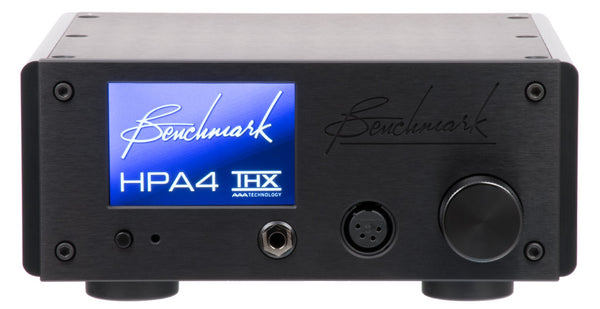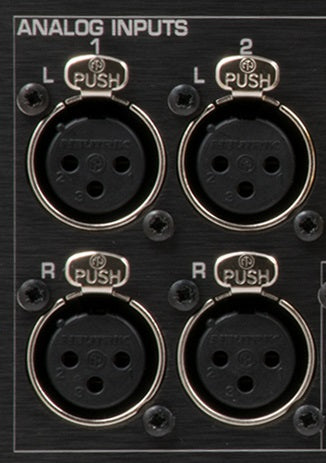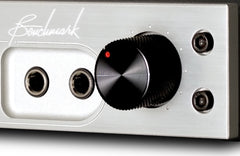Buy one component and save 10% on up to 2 cables. Buy 2 components and get 4 free cables. Free shipping on USA orders over $700.
Buy one component and save 10% on up to 2 cables. Buy 2 components and get 4 free cables. Free shipping on USA orders over $700.
Audio Myth - Balanced Headphone Amplifiers are Better
by John Siau September 15, 2016

This Myth Goes Something Like This:
"Balanced headphone amplifiers are better."
"If balanced line-level connections work well, balanced headphone outputs should also work well."
We disagree!
Benchmark does not offer voltage-balanced headphone outputs on any of its products. The reason for this is that a voltage-balanced interface serves no useful purpose when driving headphones. The truth is that a conventional single-ended headphone drive is technically superior to a balanced drive. This paper explains why single-ended headphone amplifiers are inherently more transparent than balanced headphone amplifiers.

We do offer a 4-pin XLR connection on the HPA4 headphone amplifier, because this 4-pin connection offers lower contact resistance than a traditional 1/4" TRS connection. For performance reasons, this connector is not driven with a voltage-balanced signal. Instead, it provides isolated left and right ground returns that are individually connected to the ground reference points in the left and right amplifiers. This high-quality XLR connector provides very low contact resistance and this eliminates the distortion that can be produced by the much higher contact resistance of a TRS connector. The THX-888 headphone amplifier in the HPA4 is virtually distortion free and this makes it easy to measure the distortion caused by poor TRS connections. For convenience, we also provide a TRS jack. If the TRS jack must be used, we recommend using a gold-plated plug that shows no signs of plating wear. We find that the gold plating on TRS plugs wears quickly when headphones are plugged and unplugged.

Please understand that Benchmark strongly encourages the use of balanced line-level interfaces between audio products. All of our products are equipped with fully-balanced XLR analog inputs and outputs. In these box-to-box line-level connections, a balanced interface can provide substantial performance improvements. Balanced line-level interfaces reject hum and noise while providing a higher voltage level. The higher signal levels can improve the SNR (signal to noise ratio) of the audio system.
If balanced connections work so well between audio boxes, it seems reasonable to expect improvements when driving headphones with a voltage-balanced feed. This expectation provides a marketing opportunity for any audio manufacturer that is willing to exploit customer expectations. Many are willing, and this is how audio myths are born and nurtured. Benchmark does not promote these myths nor does it embrace trends that do not contribute to transparent sound.
This expectation that balanced headphone amplifiers should be superior to single-ended amplifiers, ignores some of the most basic laws of electricity. The current into and out of a two-wire network is always equal and opposite. This means that the two-wire transducers used in headphones always see fully-balanced current. It also means that the headphone drivers are completely ignorant of the difference between single-ended and balanced-drive voltages.
Let me spell this out again: Headphone transducers are balanced devices. They have two wires. The electrons that flow into one wire must flow out of the other. The current is always balanced. The headphone transducers cannot detect the difference between a single-ended drive and a voltage-balanced drive. The system is balanced with either type of voltage drive.
But, this does not mean that balanced and unbalanced headphone amplifiers will sound the same! In many cases, voltage-balanced headphone amplifiers will produce more noise and more distortion than single-ended amplifiers of an identical design. The reason for this is that two separate output amplifiers are required in a voltage-balanced amplifier, and each must drive one half of the transducer's load impedance. The output noise will double because there are two amplifiers instead of one. The damping factor will degrade by a factor of 2 because both amplifiers contribute to the source impedance of the balanced amplifier (output impedance is doubled). Distortion will usually increase because each amplifier is required to drive half of the impedance that would be seen by an unbalanced amplifier. Power consumption will increase by a factor of 4 for a given output level (assuming the power supply voltage rails remain unchanged).
In fairness to balanced designs, I should point out that a balanced output can deliver 4 times the power for a given power supply voltage. However, this would only be necessary if the product was battery operated. The balanced output would offer no real advantage in an AC powered amplifier.
Please note that distortion is not always a bad thing (see Two Distinct Types of Audio Products). Many audio products are designed to add some harmonic distortion in an effort to add warmth to the audio reproduction. This is an artistic choice that will change the way a recording sounds. If the goal is to add distortion, a balanced headphone amplifier may produce more harmonics than a single-ended design.
In contrast, Benchmark products are designed for maximum transparency. Our goal is to build products that faithfully capture and reproduce music. This means that our products are not designed to alter the sound of a recording. This transparency is critical in a studio monitoring chain. We feel that this also makes our products well-suited for home playback when a listener wants to hear the music the way it was heard in the studio. A voltage-balanced headphone amplifier would run contrary to our goals.

The Benchmark DAC1 and DAC2 converters include Benchmark's highly-transparent HPA2™ headphone power amplifier. The near-zero Ohm output impedance of the HPA2™ gives it outstanding control over the headphone drivers, while its low distortion keeps the presentation true to the original recording.
 The all-analog HPA4 headphone power amplifier is Benchmark's flagship headphone amplifier. It incorporates the same THX-AAA technology that we use in the AHB2 power amplifier. The HPA4 is built around the flagship THX-888 headphone amplifier and is driven from a Benchmark relay-controlled attenuator and input stage. The HPA4 provides higher output levels than the HPA2 and it can drive lower impedances. The HPA4 is virtually distortion free, even when driving difficult impedances and phase angles.
The all-analog HPA4 headphone power amplifier is Benchmark's flagship headphone amplifier. It incorporates the same THX-AAA technology that we use in the AHB2 power amplifier. The HPA4 is built around the flagship THX-888 headphone amplifier and is driven from a Benchmark relay-controlled attenuator and input stage. The HPA4 provides higher output levels than the HPA2 and it can drive lower impedances. The HPA4 is virtually distortion free, even when driving difficult impedances and phase angles.
Note: Updated 10/10/18 to clarify the function of the 4-pin XLR on the HPA4 - JS
Also in Audio Application Notes

How Loud is the Distortion from Your Power Amplifier?
by John Siau August 08, 2025
Would you put a Washing Machine in your Listening Room?
If the answer is no, you may be surprised to discover that the distortion produced by your power amplifier may be louder than the noise produced by a major appliance.
Don't believe me? Take a look at Stereophile's test reports:
We selected 7 power amplifiers from Stereophile's top list of recommended amplifiers.
We took Stereophile's "THD+N vs. Power" plots for each, and replotted the data in a format that shows the loudness of the THD+N at the listening position.
The results are shocking!
Amplifier THD+N is louder than expected!
The distortion from your amplifier may be louder than a washing machine on the spin cycle, or it may be totally silent. How does yours perform? The answer is hidden in Stereophile's THD+N plots.
This application note reveals the hidden truth:
"The Distortion from your Power Amplifier may be Louder than a Washing Machine!"
I know, it sounds crazy, but this is what the measurements show!

Interpolator Overload Distortion
by John Siau November 20, 2024
Most digital playback devices include digital interpolators. These interpolators increase the sample rate of the incoming audio to improve the performance of the playback system. Interpolators are essential in oversampled sigma-delta D/A converters, and in sample rate converters. In general, interpolators have vastly improved the performance of audio D/A converters by eliminating the need for analog brick wall filters. Nevertheless, digital interpolators have brick wall digital filters that can produce unique distortion signatures when they are overloaded.
10% Distortion
An interpolator that performs wonderfully when tested with standard test tones, may overload severely when playing the inter-sample musical peaks that are captured on a typical CD. In our tests, we observed THD+N levels exceeding 10% while interpolator overloads were occurring. The highest levels were produced by devices that included ASRC sample rate converters.

Audiophile Snake Oil
by John Siau April 05, 2024
The Audiophile Wild West
Audiophiles live in the wild west. $495 will buy an "audiophile fuse" to replace the $1 generic fuse that came in your audio amplifier. $10,000 will buy a set of "audiophile speaker cables" to replace the $20 wires you purchased at the local hardware store. We are told that these $10,000 cables can be improved if we add a set of $300 "cable elevators" to dampen vibrations. You didn't even know that you needed elevators! And let's not forget to budget at least $200 for each of the "isolation platforms" we will need under our electronic components. Furthermore, it seems that any so-called "audiophile power cord" that costs less than $100, does not belong in a high-end system. And, if cost is no object, there are premium versions of each that can be purchased by the most discerning customers. A top-of-the line power cord could run $5000. One magazine claims that "the majority of listeners were able to hear the difference between a $5 power cable and a $5,000 power cord". Can you hear the difference? If not, are you really an audiophile?

